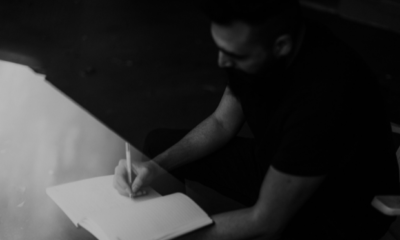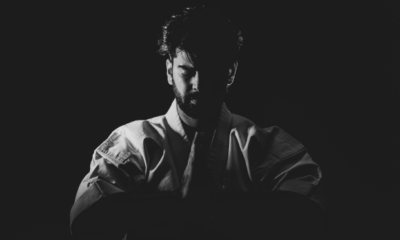Life
Boosting Your Creativity in 3 Easy Steps

“I am simply not creative.” How many times have you said this to yourself or others? I’d imagine quite a few times. Many people believe that creativity is a gift they do not own, a very luxury gift actually, only destined for a select few. I want to break this myth right now and say that creativity is a gift that every single one of us has within ourselves.
The reason why many people do not see it is because they do not allow it to be, they hide it and fear it every single day. Many believe that creativity is only for certain types of people working with art for instance or other creative professions. Albert Einstein said that “Creativity is intelligence having fun.” So every possible intelligent person on this planet can have the chance to be creative and every one of us is intelligent in our own creative way.
Creativity to me is about freedom of expression, freedom of words and behaviour, freedom to be who you truly are and show what you truly love. It is often suppressed because it can be judged as foolish, not being adequate enough, not serious enough, too colourful or too flamboyant. How many times do you wish you could wear that beautiful colourful hat you are keeping in the loft but are too scared to do it as people might think you have gone crazy?
This is a very typical example of how creativity is suppressed daily. Today I want to encourage you to connect deeply to your creativity, to find it, unleash it, and let it be the light in your life. I want to invite you to play with it and start realising that creativity is a gift you have that wants to be expressed and that can be used positively in many areas of your life.
- Creativity can help you stand out in your business.
- Creativity can help you give positivity and fun to your life.
- Creativity can help you connect to your true desires.
- How can you connect to your creativity more?
“The desire to create is one of the deepest yearnings of the human soul.” – Dieter F. Uchtdorf
Here are three easy steps for you:
1. Connect to your inner child
Just close your eyes and go back in time to all the games you used to play and all the activities you used to do as a child. Go back to relive the things you truly loved doing. Were you passionate about colours? Did you use to make clothes or play with marionettes? Maybe your passion was acting, or you always dreamt about flying?
Give a voice to your inner child, let him or her out and play and fully express themselves and bring that expression and passion into your daily life, your ideas and projects. Your life will start to be much more colourful and joyful through using creative imagination.
2. Stop the self-critics
This is such a fundamental step to take if you truly want the creative inner you to come out. Bringing out your creativity can feel scary especially as humans always fear being judged and criticised and have a strong desire to fit in and to comply with the masses.
Ask yourself what is more painful for you, to repress your inner creativity and conform or to be fully creative and possibly not being liked by a few? Put your hand to your heart when you ask yourself this question and see what feels right for you.
“You can’t use up creativity. The more you use the more you have.” – Maya Angelou
3. Stop rushing and start observing more
Creativity will have a tough time coming out if your mind is always busy with stuff, worried, and overthinking about daily problems. Taking time to relax and calm your mind will help you notice the beauty around you. It will help you “see” things you might not see while running around, which could give you lots of creative ideas.
Some of my most creative moments are when I am out in nature watching the leaves moving and the birds flying or simply watching people passing by, without worrying about the whole world. During those moments, your mind is relaxed and can more easily generate ideas and get inspired by the world around you.
One last piece of advice I want to share with you is this: every time you get a creative idea, a creative hit for doing something, creating something, or writing something just do it. The more time you leave before taking action, the more your fears will jump all over your creativity and leave very little left of it. And if that happens, the same old same old boring patterns and ideas will keep dominating in your life.
How do you boost your creative side when you need it? Share your ideas and thoughts with us below!
Life
10 Research-Backed Steps to Create Real Change This New Year
This New Year could finally be the one where you break old patterns and create real, lasting change.

Every New Year, we make plans and set goals, but often repeat old patterns. (more…)
Life
9 Harsh Truths Every Young Man Must Face to Succeed in the Modern World
Before chasing success, every young man needs to face these 9 brutal realities shaping masculinity in the modern world.

Many young men today quietly battle depression, loneliness, and a sense of confusion about who they’re meant to be.
Some blame the lack of deep friendships or romantic relationships. Others feel lost in a digital world that often labels traditional masculinity as “toxic.”
But the truth is this: becoming a man in the modern age takes more than just surviving. It takes resilience, direction, and a willingness to grow even when no one’s watching.
Success doesn’t arrive by accident or luck. It’s built on discipline, sacrifice, and consistency.
Here are 9 harsh truths every young man should know if he wants to thrive, not just survive, in the digital age.
1. Never Use Your Illness as an Excuse
As Dr. Jordan B. Peterson often says, successful people don’t complain; they act.
Your illness, hardship, or struggle shouldn’t define your limits; it should define your motivation. Rest when you must, but always get back up and keep building your dreams. Motivation doesn’t appear magically. It comes after you take action.
Here are five key lessons I’ve learned from Dr. Peterson:
-
Learn to write clearly; clarity of thought makes you dangerous.
-
Read quality literature in your free time.
-
Nurture a strong relationship with your family.
-
Share your ideas publicly; your voice matters.
-
Become a “monster”, powerful, but disciplined enough to control it.
The best leaders and thinkers are grounded. They welcome criticism, adapt quickly, and keep moving forward no matter what.
2. You Can’t Please Everyone And That’s Okay
You don’t need a crowd of people to feel fulfilled. You need a few friends who genuinely accept you for who you are.
If your circle doesn’t bring out your best, it’s okay to walk away. Solitude can be a powerful teacher. It gives you space to understand what you truly want from life. Remember, successful men aren’t people-pleasers; they’re purpose-driven.
3. You Can Control the Process, Not the Outcome
Especially in creative work, writing, business, or content creation, you control effort, not results.
You might publish two articles a day, but you can’t dictate which one will go viral. Focus on mastery, not metrics. Many great writers toiled for years in obscurity before anyone noticed them. Rejection, criticism, and indifference are all part of the path.
The best creators focus on storytelling, not applause.
4. Rejection Is Never Personal
Rejection doesn’t mean you’re unworthy. It simply means your offer, idea, or timing didn’t align.
Every successful person has faced rejection repeatedly. What separates them is persistence and perspective. They see rejection as feedback, not failure. The faster you learn that truth, the faster you’ll grow.
5. Women Value Comfort and Security
Understanding women requires maturity and empathy.
Through books, lectures, and personal growth, I’ve learned that most women desire a man who is grounded, intelligent, confident, emotionally stable, and consistent. Some want humor, others intellect, but nearly all want to feel safe and supported.
Instead of chasing attention, work on self-improvement. Build competence and confidence, and the rest will follow naturally.
6. There’s No Such Thing as Failure, Only Lessons
A powerful lesson from Neuro-Linguistic Programming: failure only exists when you stop trying.
Every mistake brings data. Every setback builds wisdom. The most successful men aren’t fearless. They’ve simply learned to act despite fear.
Be proud of your scars. They’re proof you were brave enough to try.
7. Public Speaking Is an Art Form
Public speaking is one of the most valuable and underrated skills a man can master.
It’s not about perfection; it’s about connection. The best speakers tell stories, inspire confidence, and make people feel seen. They research deeply, speak honestly, and practice relentlessly.
If you can speak well, you can lead, sell, teach, and inspire. Start small, practice at work, in class, or even in front of a mirror, and watch your confidence skyrocket.
8. Teaching Is Leadership in Disguise
Great teachers are not just knowledgeable. They’re brave, compassionate, and disciplined.
Teaching forces you to articulate what you know, and in doing so, you master it at a deeper level. Whether you’re mentoring a peer, leading a team, or sharing insights online, teaching refines your purpose.
Lifelong learners become lifelong leaders.
9. Study Human Nature to Achieve Your Dreams
One of the toughest lessons to accept: most people are self-interested.
That’s not cynicism, it’s human nature. Understanding this helps you navigate relationships, business, and communication more effectively.
Everyone has a darker side, but successful people learn to channel theirs productively into discipline, creativity, and drive.
Psychology isn’t just theory; it’s a toolkit. Learn how people think, act, and decide, and you’ll know how to lead them, influence them, and even understand yourself better.
Final Thoughts
The digital age offers endless opportunities, but only to those who are willing to take responsibility, confront discomfort, and keep improving.
Becoming a man today means embracing the hard truths most avoid.
Because at the end of the day, success isn’t about luck. It’s about who you become when life tests you the most.
Change Your Mindset
The Four Types of Happiness: Which One Are You Living In?
Most people chase success only to find emptiness, this model reveals why true happiness lies somewhere else.

In a world driven by rapid technological growth and constant competition, many people unknowingly trade joy for achievement. (more…)
Change Your Mindset
The Secret Daily Routines Behind History’s Most Brilliant Thinkers
Uncover the daily rituals and hidden habits that powered history’s most brilliant minds to success.

Why Daily Rituals Matter
Every great achiever has one thing in common: discipline. Behind the novels, inventions, discoveries, and masterpieces are small, consistent habits repeated daily. (more…)
-

 Change Your Mindset4 weeks ago
Change Your Mindset4 weeks agoThe One Leadership Habit That Separates the Great From the Forgettable
-

 Personal Development3 weeks ago
Personal Development3 weeks agoThis Silent Habit Might Be Sabotaging Your Career
-

 Business3 weeks ago
Business3 weeks agoWhy Your E-Commerce Fulfilment Is Probably Broken (And How to Fix It)
-

 Shift Your Mindset2 weeks ago
Shift Your Mindset2 weeks ago11 E’s That Define Every Great Leader And Why Most People Miss Them
-

 Did You Know2 weeks ago
Did You Know2 weeks agoThe Success Patterns You Inherited (And Didn’t Notice)
-

 Business2 weeks ago
Business2 weeks agoThe Hidden Money Pit in Your Operations (and How to Use It)
-

 Entrepreneurs1 week ago
Entrepreneurs1 week agoThe Essential Skills Every Entrepreneur Needs In 2026
-

 Change Your Mindset6 days ago
Change Your Mindset6 days agoHow to Turn Your Mind Into Your Greatest Asset (Instead of Your Enemy)


























